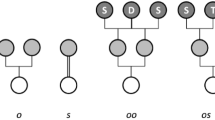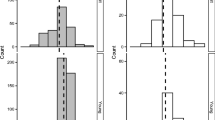Summary
Existing genetic models of the evolution of sibmating behaviour in diploids incorporate inbreeding depression in terms of reduced fecundity of consanguineous mating pairs rather than reduced survival or fecundity of the progeny of such matings. Here we derive a model to correct this deficiency and extend the model to haplodiploids where differential effects of inbreeding in males and females is a crucial consideration. Our analyses indicate that sibmating can readily evolve in both diploids and haplodiploids in which male mating costs and inbreeding depression are reasonably low, provided there is some mechanism to permit sibmating such as siblings being reared in nests or other forms of aggregation. Our analyses also indicate that once sibmating invades, it typically will go to fixation, although sib-/randommating polymorphisms can persist in both diploids and haplodiploids if male mating costs are close to zero and inbreeding depression reduces survival by around one-third. The conditions favouring sibmating are slightly more restrictive in haplodiploids than in diploids. In light of this we may ask why we see intense sibmating in many haplodiploids such as parasitic wasps, fig wasps, ants, bark beetles and mites, and only rarely in diploid animals. The common factor could be certain kinds of aggregation behaviour that are a prerequisite for sibmating in the absence of kin recognition. Another possibility is that inbreeding depression is likely to be more severe in diploids than in haplodiploids because deleterious recessives are purged from haplodiploid populations when expressed by haploid males. Thus, lower levels of inbreeding depression might be one important reason why sibmating appears to arise more frequently in haplodiploids than diploids. Phylogenetic analysis of groups, such as bark beetles and mites, exhibiting both diploid and haplodiploid populations may be useful in elucidating the relative importance of gregarious behaviour and haplodiploidy in facilitating sibmating systems.
Similar content being viewed by others
References
Brown, S. W. (1964) Automatic frequency response in the evolution of male haploidy and other coccid chromosome systems.Genetics 45, 257–74.
Bull, J. J. (1983)Evolution of Sex Determining Mechanisms. Benjamin/Cummings, Menlo Park, CA, USA.
Bulmer, M. D. (1973) Inbreeding in the great tit.Heredity 30, 313–25.
Buskirk, R. E., Frohlich, C. and Ross, K. G. (1984) The natural selection of sexual cannibalism.Am. Nat. 123, 612–25.
Charnov, E. L. (1982)The Theory of Sex Allocation. Princeton University Press, Princeton, NJ, USA.
Cowan, D. P. (1979) Sibling mating in a hunting wasp: adaptive inbreeding?Science 205, 1403–5.
Crozier, R. A. (1977) Evolutionary genetics of the Hymenoptera.Annu. Rev. Entomol. 22, 263–88.
Edelstein-Keshet, L. (1989)Mathematical Models in Biology. Random House, NY, USA.
Eickwort, G. C. (1981) Presocial insects. InSocial Insects (Vol. 2) (H. R. Herman, ed.) pp. 199–281. Academic Press, NY, USA.
Entwistle, P. F. (1964) Inbreeding and arrhenotoky in the ambrosia beetleXylebrous compactus (Eich.) (Coleoptera: Scolytidae).Proc. Roy. Entomol. Soc. Lond. A 39, 83–8.
Feldman, M. W. and Christiansen, F. B. (1984) Population genetic theory of the cost of inbreeding.Am. Nat. 123, 642–53.
Greenwood, P. J., Harvey P. H. and Perrins, C. M. (1978) Inbreeding and dispersal in the great tit.Nature 271, 52–4.
Halffter, G. and Edmunds, W. G. (1982)The Nesting Behavior of Dung Beetles (Scarbaeinae). Publicacion del Instituto de Ecologia,10, Mexico, D.F.
Hamilton, W. D. (1967) Extraordinary sex ratios.Science 156, 477–88.
Hamilton, W. D. (1979) Wingless and fighting males in fig wasps and other insects. InSexual Selection and Reproductive Competition in Insects (M. S. Blum and N. A. Blum, eds) pp. 167–220. Academic Press, NY, USA.
Hartl, D. L. and Brown, S. W. (1970). The origin of male haploid genetic systems and their expected sex ratio.Theor. Pop. Biol. 1, 165–90.
Hill, J. L., (1974)Peromyscus: effect of early pairing on reproduction.Science 186, 1042–4.
Holsinger, K. E., Feldman, M. W. and Christiansen, F. B. (1986) The evolution of self-fertilization in plants: a population genetic model.Am. Nat. 124, 446–53.
Kaitala, V. and Getz, W. M. (1992) Sex ratio genetics and the competitiveness of parasitic wasps.Bull. Math. Biol. (in press).
Karlin, S. and Lessard, S. (1986)Sex Ratio Evolution. Princeton University Press, Princeton, NJ, USA.
Kirkendall, L. R. (1983) The evolution of mating systems in bark and ambrosia beetles (Coleoptera: Scolytidae and Platypodidae).Zool. J. Linn. Soc. 77, 293–352.
Kirkendall, L. R. (1991) Ecology and evolution of biased sex ratios in bark and ambrosia beetles. inEvolution and Diversity of Sex Ratios: Insects and Mites (D. L. Wrensch and M. A. Ebbert, eds). Chapman and Hall, NY, USA (in press).
Leuze, C. C. K. (1980) The application of radio tracking and its effects on the behavioral ecology of the water vole,Arvicola terrestris (Lacépéde). InA Handbook on Biotelemetry and Radio Tracking (C. J. Amlamer and D. W. MacDonald, eds) pp. 361–6. Pergamon Press, Oxford, UK.
Maddison, W. P. (1990) A method for testing for correlated evolution of two binary characters: are gains or losses concentrated on certain granches of a phylogenetic tree.Evolution 44, 539–57.
Maynard Smith, J. (1984) The ecology of sex. InBehavioural Ecology: an Evolutionary Approach, 2nd edn. (J. R. Krebs and N. B. Davies, eds) pp. 201–21. Blackwell Scientific, Oxford.
Michener, C. D. (1974)The Social Behavior of the Bees. Harvard University Press, Cambridge, MA.
Monteith, G. B. and Storey, R. I. (1981) The biology ofCephalodesmius, a genus of dung beetles which synthesizes “dung” from plant material (Coleoptera: Scarabaeidae: Scarabaeinae).Mem. Qd. Mus. 20, 253–77.
Moritz, R. F. A. (1986) The origin of inbreeding depression in honeybees.Bee World 67, 157–163.
Nelson-Rees, W. A., Hoy, M. A. and Roush, R. T. (1980) Heterochromatinization, chromatin elimination and haploidization in the parahaploid miteMetaseiulus occidentalis (Nesbitt) (Acarina: Phytoseiidae).Chromosoma 77, 262–76.
Nonacs, P. (1986) Ant reproductive strategies and sex allocation theory.Q. Rev. Biol. 61, 1–21.
Oliver, J. H. (1977) Cytogenetics of mites and ticks.Annu. Rev. Entomol. 22, 407–29.
Oliver, J. H. (1983) Chromosomes, genetic variance and reproductive strategies among mites and ticks.Bull. Entomol. Soc. Am. 29, 8–17.
Page, R. E. (1980) The evolution of multiple mating behavior by honey bee queens (Apis mellifera L.).Genetics 96, 263–73.
Passera, L., Keller, L. and Suzzoni, J. (1988) Queen replacement in dequeened colonies of the Argentine antIridomyrmex humilis (Mayr).Psyche 95, 59–63.
Price, M. V. and Waser, N. M. (1979). Pollen dispersal and optimal outcrossing inDelphinium nelsoni.Nature 277, 294–7.
Ratnieks, F. L. W. (1991) The evolution of genetic odor cue diversity in social Hymenoptera.Am. Nat. 137, 202–26.
Scott, M. and Traniello, J. F. A. (1990) Behavioural and ecological correlates of male and female parental care and reproductive success in burying beetles (Nicrophorus spp.).Anim. Behav. 39, 274–83.
Shields, W. M. (1982)Philopatry, Inbreeding, and the Evolution of Sex. State University of New York Press, Albany, NY, USA.
Suzuki, Y. and Hiehata, K. (1985) Mating system and sex ratios in the egg parasitoids,Trichogramma dendrolimi andT. papilionis (Hymenoptera: Trichogrammatidae).Anim. Behav. 33, 1223–7.
Thornhill, R. and Alcock, J. (1983)The Evolution of Insect Mating Systems. Harvard University Press, Cambridge, MA, USA.
Waage, J. K. (1982) Sib-mating and sex ratio strategies in scelionid wasps.Ecol. Entomol.,7, 103–12.
Waage, J. (1986) Family planning in parasitoids: adaptive patterns of progeny and sex allocation. InInsect Parasitoids (J. K. Waage and D. Greathead, eds) pp. 63–95. Academic Press, London.
Wang, Y. H. and Gutierrez, A. P. (1980) An assessment of the use of stability analyses in population ecology.J. Anim. Ecol. 49, 435–52.
Waser, P. M., Austad, S. N. and Keane, B. (1986) When should animals tolerate inbreeding?Am. Nat. 128, 529–37.
Werren, J. H. (1980) Sex ratio adaptations to local mate competition in a parasitic wasp.Science 208, 1157–9.
Wood, S. L. (1982) The bark and ambrosia beetles of North and Central America (Coleoptera: Scolytidae), a taxonomic monograph.Great Basin Naturalist Memoirs 6, 1–1359.
Author information
Authors and Affiliations
Rights and permissions
About this article
Cite this article
Getz, W.M., Kaitala, V. & Ratnieks, F.L.W. Invasion of sibmating genes in diploid and haplodiploid populations. Evol Ecol 6, 312–330 (1992). https://doi.org/10.1007/BF02270968
Issue Date:
DOI: https://doi.org/10.1007/BF02270968




